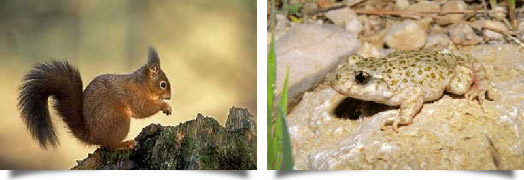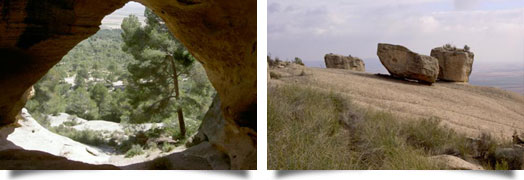
MONTE ARABÍ
The Arabí appears as a large stone structure that stands out on the environment in a characteristic way. The passage is of great beauty and uniqueness. The biocalcarenites abound with intercalations of a quartz mineral called "hyacinth of Compostela" But perhaps the most noticeable are the erosive phenomena that have caused the formation of large rounded blocks, holes, caves, shelters, and huge surfaces of "honeycombs" or alveoli in the rock walls of the biocalcarenitas.
The archaeological interest of the zone is undoubted. There are materials and artistic representations among which the pictorial shelters of the Cueva del Mediodía and Cantos de Visera I and II stand out. Equally noteworthy are the so-called cazoletas and petroglyphs , whose exact meaning is unknown. The many legends of this mountain, expressed at a popular level and in written sources, are an inseparable part of this space.
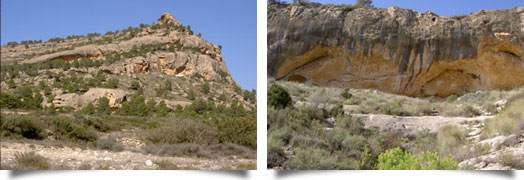
The vegetal canopy is dominated by the Aleppo pine (Pinus halepensis) found throughout the mountain. Oaks are still found, especially in shady areas, which are accompanied by numerous species of flora, some of them endemic. Another interesting aspect of the Arabí is the abundance and varied fauna that it houses.
In addition to numerous invertebrates, reptiles and mammals, the landscape stands out for its high ornithic richness, which is probably one of the areas with the greatest diversity of birds in the Jumilla-Yecla Altiplano.
SIERRA DE LAS PANSAS AND REGIONAL PARK OF CARCHE
The Sierra de las Pansas constitutes a mountainous group of certain elevation, representing a morphological and forestry continuation of the Carche massif on its part NE, of which it is independent in a certain way through the ravines of El Salvador and La Yedra, both in the term of Jumilla, but near the limit of Yecla. The Sierra del Carche is declared as a Regional Park, which also includes the Pansas.
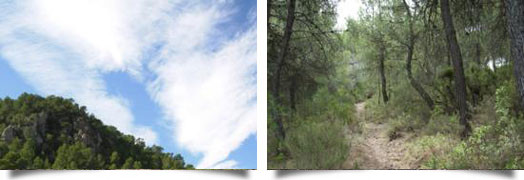
In Las Pansas, a forest landscape of great value is presented. The northern part of the massif is the most interesting, where there are ravines and some rocky crags in the high parts that stand out among the pine forest. Its maximum altitude is 1,036 meters above sea level . There is a small spring in the skirts of the shady Las Pansas, and some caves like Jaime Barbudo, which popular tradition says was the hiding place of this famous bandit.
Some repopulations have been carried out with Aleppo pine in specific areas, but most of the pine forest is of natural origin, being in the shadow of the sierra and in some ravines the most interesting areas, covered with a tight pine forest to which oaks accompany, as well as bushes that form an impenetrable maquis.
The fauna is mainly concentrated in the different ecological niches that make up the forest and the thicket of the mountain range, highlighting the presence of species that live in well preserved forest environments and that constitute the best demonstration of the high ecological value of the area . Among mammals it is necessary to point out the boar's abundance.
SIERRA DE SALINAS
The Sierra de Salinas is one of the most important forest ecosystems of the Comarca del Altiplano. The aspect of the mountain range is wild, with notable ravines wedged between its slopes. The summit of the mountain range is known as "Capilla del Fraile" and has 1,237 m. of altitude above sea level, which makes it the highest point of the municipal district of Yecla and the second of the Altiplano.
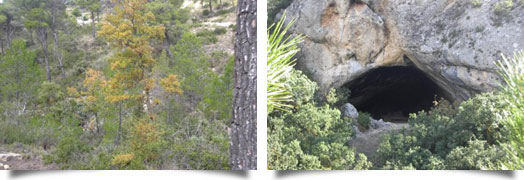
The shade, ravines and cliffs of the sierra, in the northern part of the massif, are undoubtedly the most interesting part of the area, covered by a dense forest of Aleppo pines, with specimens of great size and age, most of natural origin .
Above 950 m. At altitude the holm oak appears, with a smaller area than it should have been in the past, and which is accompanied by gall oaks in the wettest ravines. Next to them, and in tight underbrush, kermes oak, strawberry, durillos, honeysuckle, cornicabra.
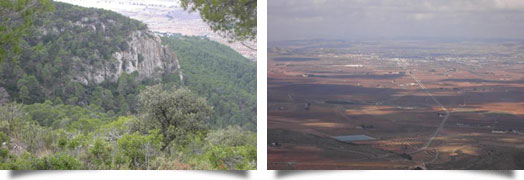
The diversity of fauna that inhabits the landscape is enormous , distributed by the various biotopes that make up the landscape of the Sierra. The pine forest is the most favorable environment for many of them, also taking advantage of a good number of species existing crops in the skirts to feed.
SIERRA DEL SERRAL
Sierra of considerable length, in which the existence of numerous cliffs, rocks and crags stands out. The existence of rocks provides landscape interest to the whole, appearing in sunbeds with more broken and broken forms than in the shady, where the rock tends to form more vertical walls.
Forest relatively well preserved with pines of great size and accompanying noble scrub, especially in the shade, which retains a Pinus halepensis pine that in some areas is adult, accompanied by scrub type maquia and some holm oak. There are areas of stone pine and forest reforestation in the skirts.
Solanas more deforested, covered by a spartal - romeral without trees or scattered pine. Rupella vegetation of interest, with species of flora associated with extraplomos. Thyme are also found typical of rocky slopes and flora of interest associated with sands.
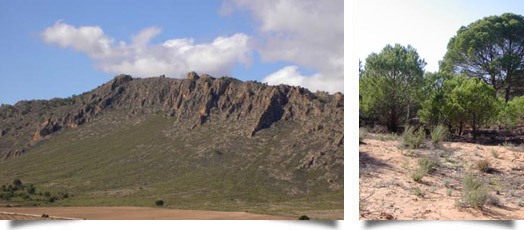
Among the species of fauna, there are several birds of prey linked to the rupicolous and forest environment, as they are the most outstanding of this mountain range. Numerous species of birds and mammals are found throughout the bush. there are currently no springs or water sources, so amphibians are very scarce and only found in irrigation ponds and modern irrigation ditches.
The Sierra has place-names of great ethnographic value, such as the Barranco del Tesoro , whose origin is unknown. Some allude to diverse fauna such as the Barranco del Búho, Barranco del Paire (refers to the shrill sparrow Petronia petronia), Collado de la Peña de la Cabra ... or historical events already fallen into oblivion (Path of the Carlists, Collado de the Sergeants). In a hidden place there is a suggestive inscription, which always has flowers: "Monte Elia" ...
RAMBLA DE TOBARRILLAS
Paleolithic and Roman sites are found in the ravine and surroundings. The Tobarrillas mountains, a succession of gentle hills that extend on both sides of the ravine, also have some interesting Roman sites (Marisparza, Fuente del Pinar).
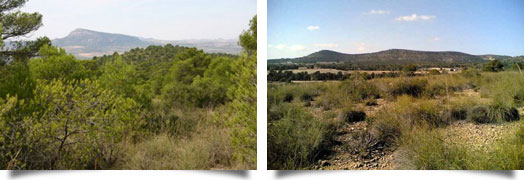
The highlight of the ravine is its middle section , where there is a riparian vegetation dominated by elm (Ulmus minor), although it is currently very degraded due to the grafiosis and the abandonment of water pipes. Next to it, numerous plants, many of them associated with water, are found here.
The peculiar environmental conditions of this place favor the existence of numerous species, some of them rare in the rest of the Region. The squirrel is a nice animal that is not difficult to observe, like many species of amphibians, mammals and birds.
